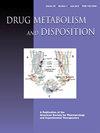同时抑制 SLC6A19 和 BCRP 转运体会导致血浆和肾脏中吲哚硫酸盐(一种尿毒症毒素)的含量增加
IF 4.4
3区 医学
Q1 PHARMACOLOGY & PHARMACY
引用次数: 0
摘要
目前正在研究将 SLC6A19 抑制剂作为治疗苯丙酮尿症的药物。在这项研究中,通过组织质谱成像(tMSI)分析,一种强效 SLC6A19 抑制剂(RA836)使大鼠肾脏尿毒症毒素吲哚硫酸酯(IDS)水平升高,强度(任意单位)为 13.7{加减}7.7,而药物为 0.3{加减}0.1(P=0.01)。我们假设,血浆和肾脏中 IDS 水平的增加可能是由于 Slc6a19 和负责将 IDS 排泄到尿液中的肾脏 IDS 转运体同时受到抑制所致。为了验证这一点,我们首先通过给大鼠喂食不含 Trp 的食物来证实 IDS 是通过色氨酸代谢形成的。用 RA836 抑制 Slc6a19 会导致这些大鼠体内的 IDS 增加。接着,在体外评估了 RA836 及其主要代谢物对肾脏转运体 OAT1、OAT3 和 BCRP 的抑制作用。RA836 抑制 BCRP 的 IC50 值为 0.045 µM,但对 OAT1 或 OAT3 没有明显抑制作用。最后,合成了对 SLC6A19 和/或 BCRP 有抑制作用或无抑制作用的 RA836 类似物,并给正常饮食的大鼠服用。收集血浆和肾脏样本,使用 LC-MS 对 IDS 进行定量。SLC6A19无活性但具有强效的BCRP抑制剂和SLC6A19有活性但具有弱效的BCRP抑制剂都不会提高IDS的水平,而抑制这两种转运体的化合物会导致IDS在大鼠血浆和肾脏中蓄积,这支持了大鼠Bcrp有助于IDS排泄的假设。总之,我们发现抑制 Slc6a19 会增加 IDS 的形成,而同时抑制 Bcrp 会导致 IDS 在肾脏和血浆中积累。本文章由计算机程序翻译,如有差异,请以英文原文为准。
The simultaneous inhibition of SLC6A19 and BCRP transporters leads to an increase of indoxyl sulfate (a uremic toxin) in plasma and kidney
SLC6A19 inhibitors are being studied as therapeutic agents for Phenylketonuria. In this work, a potent SLC6A19 inhibitor (RA836) elevated rat kidney uremic toxin indoxyl sulfate (IDS) levels by intensity (arbitrary unit) of 13.7{plus minus}7.7 compared to vehicle 0.3{plus minus}0.1 (P=0.01) as determined by tissue mass spectrometry imaging (tMSI) analysis. We hypothesized that increased plasma and kidney levels of IDS could be caused by the simultaneous inhibition of both Slc6a19 and a kidney IDS transporter responsible for excretion of IDS into urine. To test this, we first confirmed the formation of IDS through tryptophan metabolism by feeding rats a Trp-free diet. Inhibiting Slc6a19 with RA836 led to increased IDS in these rats. Next, RA836 and its key metabolites were evaluated in vitro for inhibiting kidney transporters OAT1, OAT3 and BCRP. RA836 inhibits BCRP with an IC50 of 0.045 µM but shows no significant inhibition of OAT1 or OAT3. Finally, RA836 analogs with either potent or no inhibition of SLC6A19 and/or BCRP were synthesized and administered to rats fed a normal diet. Plasma and kidney samples were collected to quantify IDS using LC-MS. Neither a SLC6A19 inactive but potent BCRP inhibitor nor a SLC6A19 active but weak BCRP inhibitor raised IDS levels, while compounds inhibiting both transporters caused IDS accumulation in rat plasma and kidney, supporting the hypothesis that rat Bcrp contributes to the excretion of IDS. In summary, we identified that inhibiting Slc6a19 increases IDS formation, while simultaneously inhibiting Bcrp results in IDS accumulation in the kidney and plasma.
求助全文
通过发布文献求助,成功后即可免费获取论文全文。
去求助
来源期刊
CiteScore
6.50
自引率
12.80%
发文量
128
审稿时长
3 months
期刊介绍:
An important reference for all pharmacology and toxicology departments, DMD is also a valuable resource for medicinal chemists involved in drug design and biochemists with an interest in drug metabolism, expression of drug metabolizing enzymes, and regulation of drug metabolizing enzyme gene expression. Articles provide experimental results from in vitro and in vivo systems that bring you significant and original information on metabolism and disposition of endogenous and exogenous compounds, including pharmacologic agents and environmental chemicals.

 求助内容:
求助内容: 应助结果提醒方式:
应助结果提醒方式:


